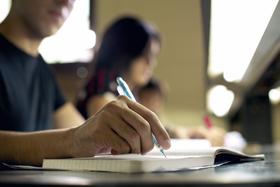Serving 210 students in grades 9-12, Byron Area High School ranks in the top 50% of all schools in Michigan for overall test scores (math proficiency is bottom 50%, and reading proficiency is bottom 50%).
The percentage of students achieving proficiency in math is 20-29% (which is lower than the Michigan state average of 35%). The percentage of students achieving proficiency in reading/language arts is 60-69% (which is higher than the Michigan state average of 45%).
The student-teacher ratio of 18:1 is higher than the Michigan state level of 17:1.
Minority enrollment is 1% of the student body (majority Hispanic), which is lower than the Michigan state average of 37% (majority Black).
Quick Facts (2025-26)
- Grades: 9-12
- Enrollment: 210 students
- Student-Teacher Ratio: 18:1
- Minority Enrollment: 1%
- Graduation Rate: ≥90% (Top 30% in MI)
- Overall Testing Rank: Top 50%
- Math Proficiency: 20-29% (Btm 50%)
- Reading Proficiency: 60-69% (Top 20%)
- Science Proficiency: 40-49% (Top 50%)
- Source: National Center for Education Statistics (NCES), MI Dept. of Education
Top Rankings
Byron Area High School ranks among the top 20% of public schools in Michigan for:
Category
Attribute
Most improved public schools
Reading/Language Arts Proficiency
School Overview
Byron Area High School's student population of 210 students has declined by 38% over five school years.
The teacher population of 12 teachers has declined by 20% over five school years.
Grades Offered
Grades 9-12
(Supplemental Virtual)
(Supplemental Virtual)
Total Students
210 students
Gender %
Total Classroom Teachers
12 teachers
Year Founded
2013
School Calendar
School Motto
SOAR Like an Eagle
School Rankings
Byron Area High School ranks within the top 50% of all 3,025 schools in Michigan (based off of combined math and reading proficiency testing data).
The diversity score of Byron Area High School is 0.02, which is less than the diversity score at state average of 0.56. The school's diversity has stayed relatively flat over five school years.
Overall Testing Rank
#1132 out of 3025 schools
(Top 50%)
(Top 50%)
Math Test Scores (% Proficient)
20-29%
35%
Reading/Language Arts Test Scores (% Proficient)
60-69%
45%
Science Test Scores (% Proficient)
40-49%
38%
Student-Teacher Ratio
18:1
17:1
American Indian
n/a
1%
Asian
n/a
4%
Hispanic
1%
9%
Black
n/a
18%
White
99%
63%
Hawaiian
n/a
n/a
Two or more races
n/a
5%
All Ethnic Groups
Graduation Rate
≥90%
81%
Participates in the National School Lunch Program (NSLP)
Yes
Eligible for Free Lunch
35%
50%
Eligible for Reduced Lunch
11%
4%
School Statewide Testing
School District Name
Source: National Center for Education Statistics (NCES), MI Dept. of Education
Profile last updated: 02/09/2025
Frequently Asked Questions
What is Byron Area High School's ranking?
Byron Area High School is ranked #1132 out of 3,025 schools, which ranks it among the top 50% of public schools in Michigan.
What schools are Byron Area High School often compared to?
Byron Area High Schoolis often viewed alongside schools like Durand Area High School by visitors of our site.
What percent of students have achieved state testing proficiency in math and reading?
20-29% of students have achieved math proficiency (compared to the 35% MI state average), while 60-69% of students have achieved reading proficiency (compared to the 45% MI state average).
What is the graduation rate of Byron Area High School?
The graduation rate of Byron Area High School is 90%, which is higher than the Michigan state average of 81%.
How many students attend Byron Area High School?
210 students attend Byron Area High School.
What is the racial composition of the student body?
99% of Byron Area High School students are White, and 1% of students are Hispanic.
What is the student-teacher ratio of Byron Area High School?
Byron Area High School has a student ration of 18:1, which is higher than the Michigan state average of 17:1.
What grades does Byron Area High School offer ?
Byron Area High School offers enrollment in grades 9-12 (Supplemental Virtual).
What school district is Byron Area High School part of?
Byron Area High School is part of Byron Area Schools.
School Reviews
5 10/10/2025
The school is small so you know most of the students in your class . Teachers are very friendly. School is starting to get more clubs and is starting to upgrade out dated policies and equipment. Great school.
2 10/10/2025
Byron High School doesn't adequately prepare students for college with the courses they offer. The teachers do not put the effort in and the discipline is either none or too harsh. The only sport they focus on is football, though they offer other activities the funding goes to football. While I know it is a small school (400 or less) there is only 1 bathroom for each sex. It is in need of upgrading as well. The class sizes at 35 students is too large for the teachers to effectively teach and/or control. I would seek other education if possible.
Review Byron Area High School. Reviews should be a few sentences in length. Please include any comments on:
- Quality of academic programs, teachers, and facilities
- Availability of music, art, sports and other extracurricular activities
Recent Articles

School Vouchers: Updated Pros and Cons (2025 Review)
Comprehensive 2025 analysis of school vouchers, weighing benefits and challenges for families, funding, outcomes, and policy directions.

Benefits and Drawbacks of Homework in 2025
Explore updated 2025 insights on homework鈥檚 benefits, drawbacks, mental health impact, best practices, and policy trends in U.S. public schools.

Charter Schools vs Public Schools 2025: Key Differences & Trends
Explore updated 2025 insights comparing charter schools vs public schools, enrollment, academic outcomes, funding, and real-world examples for families and educators.





